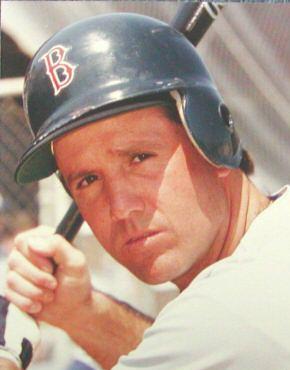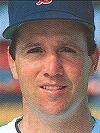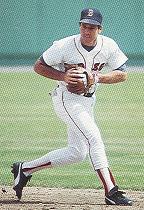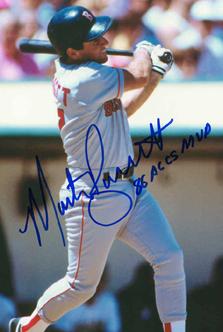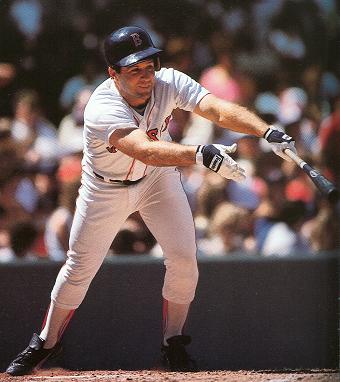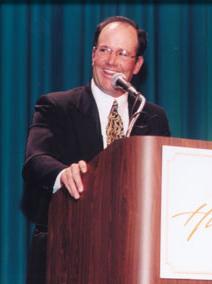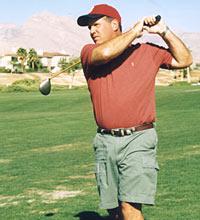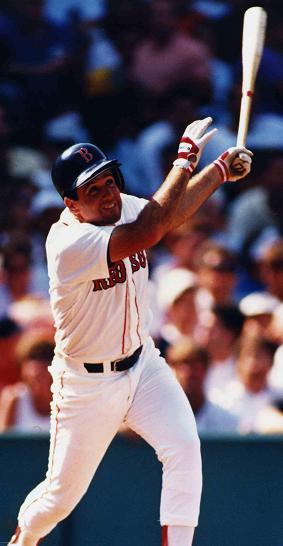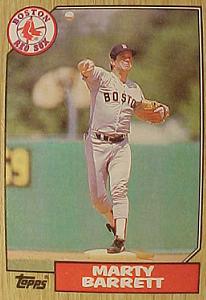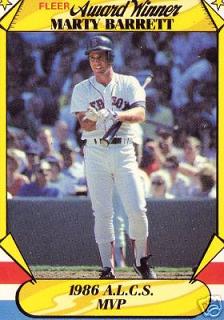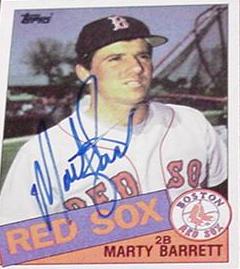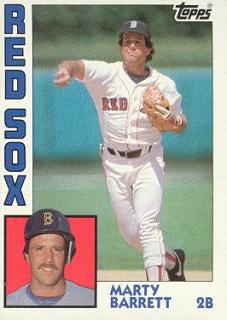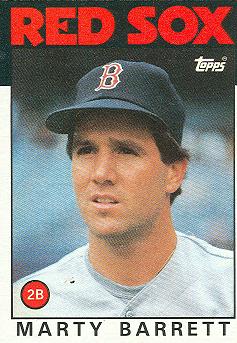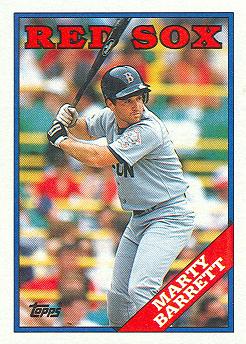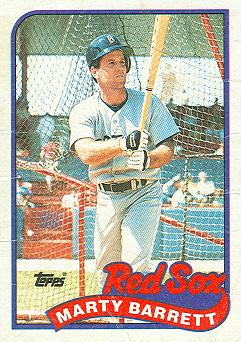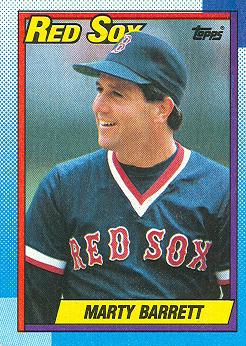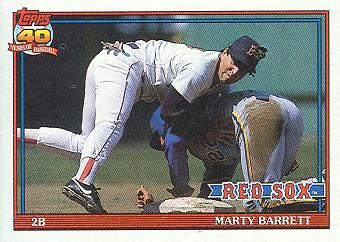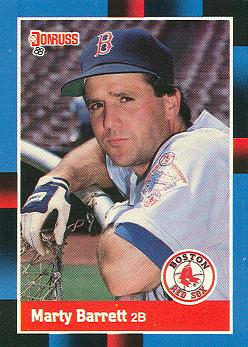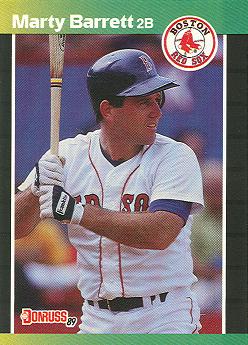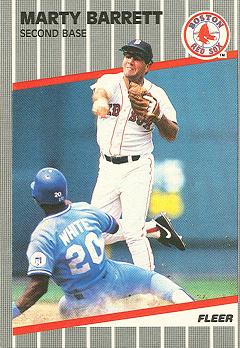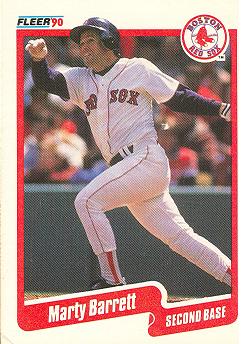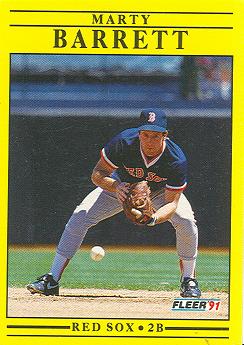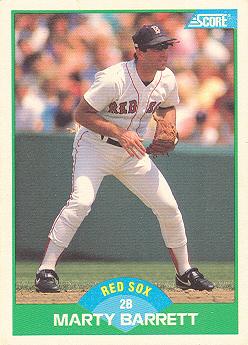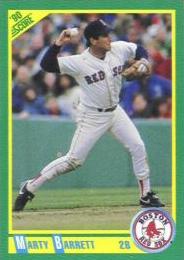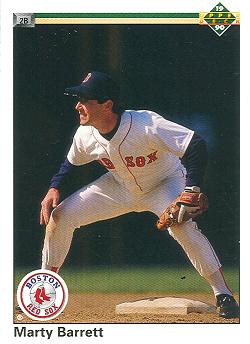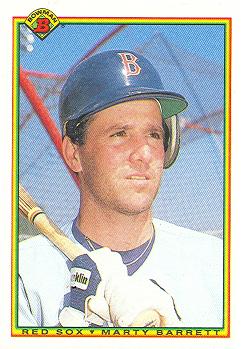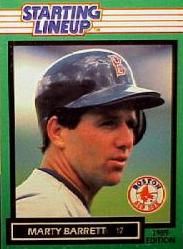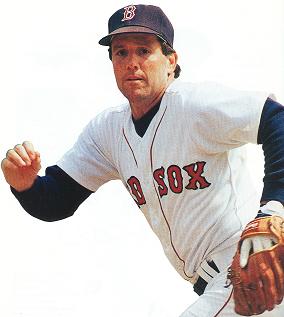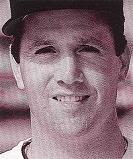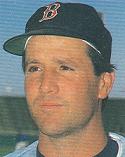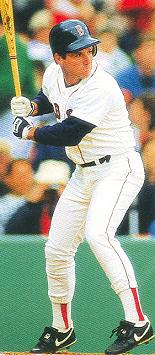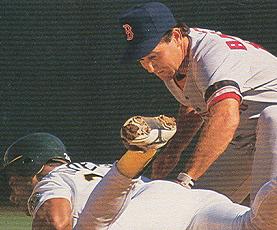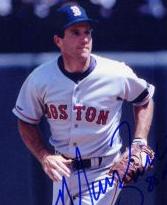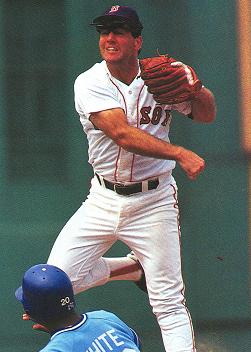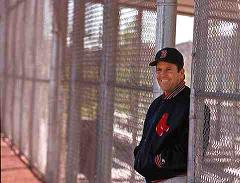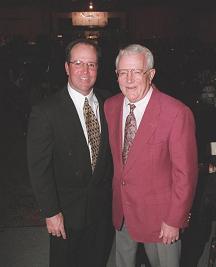Marty Barrett
Marty Barrett is the leadoff hitter and starting second baseman for Boston on the NES version of RBI.
Short Bio
- Born Martin Glenn Barrett June 23, 1958 in Arcadia, California, but grew up in Las Vegas
- Attended Arizona State University
- Drafted by the Boston Red Sox in the 1st round (1st pick) of the 1979 amateur draft (Secondary Phase).
- Played in the Big Leagues with Boston (1982-1990) and San Diego (1991)
- Named 1986 ALCS MVP after batting .367, driving in five and scoring four runs in the Red Sox’s seven-game victory
- His 11 hits in the 1986 ALCS was a then-LCS record.
- Had a base hit in each of the seven games in the 1986 World Series, batting .433 with 13 hits
- He remains one of only three players to collect 13 hits in a World Series (Bobby Richardson in 1964 and Lou Brock in 1968)
- Led the American League three consecutive seasons in sacrifice hits (1986-1988)
Full Bio
Martin Glenn Barrett was born on June 23, 1958 in Arcadia, California, and grew up in Las Vegas. He started playing Little League baseball when he was 11, and claims that six of his friends also made it to the Major Leagues. His brother Charlie pitched for a minor league affiliate of the Los Angeles Dodgers, and his brother Tom played in the Major Leagues (4 games at second base with the Red Sox). Marty idolized middle-infielders like Tim Foli growing up, and his childhood dream was to become a sportscaster.
He went to Rancho High School in North Las Vegas, lettering in baseball, basketball, and football. He made the All-Conference baseball team, and led the team to a state championship in 1976. He went on play baseball at Mesa Junior College from 1977 to 1978, where he made the All-Conference team both years (His brother Tom was All-Conference there in 1980). Marty transferred to Arizona State University in 1979.
The Angels selected him in the 1977 draft (198th overall pick in the 11th round); the Mets tried to pick him up in 1979 (56th overall pick in the 3rd round); and he even turned down his first offer to play with the Red Sox (20th overall in the 1st round). In 1979, Marty finally signed a professional baseball contract, after the Red Sox made him their first pick of the secondary phase of the 1979 June draft. Red Sox scout Ray Boone liked Barrett because of his consistency. Barrett was defensively reliable and rarely struck out.
He started his minor league career in 1979 with Winter Haven, and moved up to Bristol in 1980. In 1982, while in Pawtucket, Barrett led International League second-basemen with 99 double plays, and was named to All-Star team. He is more well-known for scoring the winning run in professional baseball’s longest game. He was one of six RBIers (Ripken, Gedman, Boggs, Ojeda, and Hurst) to play in the game; a 33-inning game between Pawtucket and Rochester on April 18, 1981. The game lasted until after 4 a.m., and it wasn’t until June 23 that the teams met to finish the game. Barrett led of the 33rd inning and was hit by a pitch. The next batter hit a single, but Barrett was running on the pitch and made it to third. The next batter was walked intentionally, and Barrett scored when then next batter singled.
In 1982, he was called up to the Major Leagues. He made his Major League debut on September 6, 1982 as a defensive substitution. The first two batters of the inning hit groundballs to Barrett, who was able to field them cleanly despite his anxiousness. After the game, he ordered a pizza and called his dad.
After spending some time in Pawtucket in 1983, Barrett began his first full season as the backup second-baseman to Jerry Remy in 1984. That year, Barrett led the American League in at-bats per strikeout (19.0); he led second-baseman with a .987 fielding percentage; and he had a career-high .303 batting average.
In 1985, Barrett hit a career-high 5 home runs. On April 20, Barrett hit his first Grand Slam. The Red Sox were playing the White Sox that day, and the score had been close for most of the game. With two out in the ninth inning, Barrett hit a Grand Slam to give the Red Sox a 12-7 lead. The Red Sox held on to win 12-8.
In 1986, Barrett had a career year. He had two 14-game hitting streaks, and finished the season with a career-best 94 runs, 179 hits, 39 doubles, and 15 stolen bases. He also led American League second-basemen with 450 assists. That year, his teammates began calling him “the computer” because of his knowledge of game situations and opposing players. Barrett also had a stellar postseason in 1986.
Barrett tied a record with 11 hits in a League Championship Series. That record has since been equaled by seven players and topped by six. His performance helped the Red Sox to the World Series, and Barrett was named the ALCS MVP. His success continued in the World Series, where he got a base it in each of the 7 games. He remains one of only three players to collect 13 hits in a World Series (Bobby Richardson in 1964 and Lou Brock in 1968). Barrett’s 24 hits are also a Major League record for a single postseason. Despite his success, it was Barrett’s strikeout in Game 7 that clinched the title for the Mets.
In 1987, Barrett again had the highest fielding percentage (.988) among A.L. second-basemen. Barrett played solid defense, but was never awarded a Gold Glove. He had his best single-game performance on June 10, 1987 against the Orioles. He went 4 for 5 with his second career Grand Slam as Boston routed Baltimore 15-4. It was one of his 11 career 4-hit games.
Marty achieved some of his more obscure accomplishments between 1987 and 1988. His 3 hidden ball tricks came during those years. Two of them came in July, 1987 against California RBIers. He caught Bobby Grich on July 7, and then caught Doug DeCinces on July 21. His third one came on September 5, 1988 to catch Jim Traber. On June 15, he stole home against the Orioles. It was the first time a Red Sox player successfully completed a straight steal of home since Tommy Harper did it in 1973.
In his prime, Barrett batted in the 2-spot behind Boggs and was just as hard to strikeout. Barrett had only 17 multi-strikeout games, and struck out only 209 times in 3378 career at-bats. Barrett was good at just putting the ball in play. He led the American League in sacrifice hits for three consecutive years (1986-1988), and his 102 sacrifice hits ties him with Tris Speaker for 10th on the Red Sox career list.
During a game against the Blue Jays in 1989, Barrett was called-on to pinch-hit. He hit a groundball to third-baseman Kelly Gruber. Gruber’s throw was wild, and it pulled first-baseman Fred McGriff off the bag. When Barrett tried to avoid the tag, his knee went out. Boston’s team physician and part-owner, Dr. Arthur Pappas, diagnosed Barrett with torn cartilage in his knee. When he got a second opinion, Barrett found out that he had actually torn his ACL. He filed a malpractice lawsuit against Dr. Arthur Pappas, the two settled out of court for $2.4 million.
Whether it was because of the court-case or the injury, Barrett’s playing time was limited in 1990. Jody Reed started playing more games at second, and Barrett even played part of a game at third base. Sensing that Reed would be taking his spot, Barrett asked for and was granted his release after the 1990 season. He would finish his career with the San Diego Padres.
In his first National League at-bat, Barrett hit a pinch-hit home run off Dave Righetti. He didn’t go to San Diego to pinch-hit though, and he certainly didn’t go there to hit home runs. He was expecting to be the starting second-baseman, but Bip Roberts had recently changed positions from left field to second base. Once again, Barrett would be replaced by younger talent.
Barrett tore his ACL again during what would be his final Major League baseball game. Phillies slugger Dale Murphy hit into a double play, and as Barrett threw to first, John Kruk took him out with a hard slide. Murphy was out at first, but Kruk’s slide left Barrett holding his knee in agony. Barrett left the game and would never play another Major League baseball game. He went to the minors for a rehab assignment where doctors told him his knee would have to be reconstructed. His playing career was over, but Barrett started a coaching career soon after.
From 1992 to 1994, Barrett was a coach for the Las Vegas Stars (Padres triple-A affiliate in the Pacific Coast League). In 1995, he coached the Rancho Cucamonga Quakes (single-A California League). He was inducted into the Southern Nevada Sports Hall of Fame in 1999, and realized his childhood goal when he became a commentator for the triple-A Dodger affiliate Las Vegas 51’s in 2001.
As his children entered high school, Barrett decided to put his career on hold to watch them grow up. He made that decision after noticing his son shuffling through some of his old baseball cards in the airport. When Marty asked his son what he was doing, he told him that he looked at his baseball cards whenever he forgot what his dad’s face looked like. Barrett now lives with his family in Summerlin. Barrett enjoys playing golf, and he makes a living through real estate in Las Vegas.
RBI Stats
- Right-handed hitter
- .286 Batting Average
- 4 Home Runs
- 735 Power Rating
- 16 Contact Rating
- 134 Speed Rating
Career Stats
| G | AB | R | H | 2B | 3B | HR | RBI | SB | BB | SO | BA | OBP | SLG | OPS |
| 941 | 3378 | 418 | 938 | 163 | 9 | 18 | 314 | 57 | 304 | 209 | .278 | .337 | .347 | .684 |
Barrett in RBI
Barrett's paltry hitting coupled with Boston's huge bench means that very few people let Barrett get any playing time. The debate ranges on which of Boston’s bench studs to bring in to lead off the game, but almost everyone agrees that either Dave Henderson, Tony Armas or Ellis Burks is a better option.
Nicknames
- Marty McFly
Hall of Shame Entries
- Went down swinging for the final out of the 1986 World Series
- Was awarded $2.4 million from the Red Sox after his torn ACL was misdiagnosed and ruined his career
RBI Baseball Cards
Other Baseball Cards
Other Pictures
